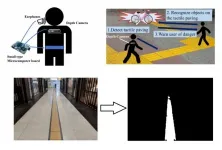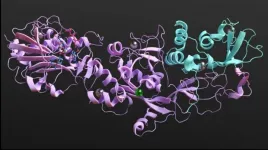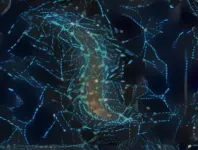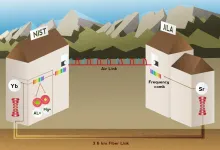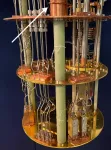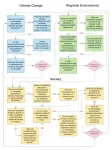(Press-News.org) Immunotherapy, which recruits the body's own immune system to attack cancer, has given many cancer patients a new avenue to treat the disease.
But many cancer immunotherapy treatments can be expensive, have devastating side effects, and only work in a fraction of patients.
Researchers at the Pritzker School of Molecular Engineering at the University of Chicago have developed a new therapeutic vaccine that uses a patient's own tumor cells to train their immune system to find and kill cancer.
The vaccine, which is injected into the skin just like a traditional vaccine, stopped melanoma tumor growth in mouse models. It even worked long-term, destroying new tumors long after the therapy was given.
The results were published March 24 in the journal Science Advances.
"This is a new strategy for immunotherapy," said Prof. Melody Swartz, who led the research. "It has the potential to be more efficacious, less expensive and much safer than many other immunotherapies. It is truly personalized medicine that has the potential to overcome many issues that arise with other treatments."
Recruiting a broad immune response
In many ways, the vaccine works like a traditional flu vaccine: it uses a less-potent version of the pathogen (here, a patient's own cancer cells, which are lethally irradiated before injection) to train the immune system to fight the disease.
However, rather than a preventive measure, this is a therapeutic vaccine, meaning it activates the immune system to destroy cancer cells anywhere in the body. To create it, Swartz and her team used melanoma cells from mice and then engineered them to secrete vascular endothelial growth factor C (VEGF-C).
VEGF-C causes tumors to strongly associate with the body's lymphatic system, which is normally considered bad for the patient, since it can promote metastasis. But the team recently found that when tumors activate surrounding lymphatic vessels, they are much more responsive to immunotherapy and promote "bystander" T cell activation, leading to a more robust and long-lasting immune response.
The team then had to figure out how to harness the benefits of lymphatic activation in a therapeutic strategy while avoiding the potential risks of metastasis.
'Training' the immune system
Maria Stella Sasso, a postdoctoral fellow and first author of the paper, tested many different strategies before settling on the vaccine approach, which allowed immune "training" in a site distant from the actual tumor.
The strategy of using a patient's own irradiated tumor cells in a therapeutic vaccine had previously been established by Glenn Dranoff and colleagues at the Novartis Institutes for BioMedical Research. Dranoff and team developed GVAX, a cancer vaccine that has been shown safe in clinical trials. Sasso decided to try this approach with VEGF-C rather than the cytokine used in GVAX. She dubbed the strategy "VEGFC-vax."
After engineering the cells to express VEGF-C, the research team irradiated them, so they would die within a few weeks. When they injected the cells back into the skin of mice, they found that the dying tumor cells could attract and activate the immune cells, which then could recognize and kill the actual tumor cells growing on the opposite side of the mouse. Since each tumor has its own unique signature of hundreds of molecules that the immune system can recognize, the vaccine promoted a broad, robust immune response.
That led to the prevention of tumor growth in all of the mice. It also led to immunological memory, preventing new tumor growth when tumor cells were re-introduced 10 months later.
"This shows that the therapy may provide long-term efficacy against metastasis and relapse," said Swartz, William B. Ogden Professor of Molecular Engineering.
Potential therapy for many types of cancers
Conceptually, this is the first strategy to exploit the benefits of local lymphatic vessel activation for more robust and specific immune response against tumor cells.
Unlike immunotherapeutic strategies that stimulate the immune system in a general way, such as checkpoint blockade or the many cytokines currently in preclinical development, this new immunotherapy activates only tumor-specific immune cells. Theoretically, this would avoid common side effects of immune stimulants, including immunotoxicity and even death.
And while many other cancer immunotherapies, such as CAR-T cell therapy, are tumor-specific, these strategies only work against tumor cells that express specific pre-identified tumor markers called antigens. Cancer cells can eventually overcome such treatments by shedding these markers or mutating, for example.
VEGFC-vax, however, can train immune cells to recognize a large number and variety of tumor-specific antigens. More importantly, these antigens do not need to be identified ahead of time.
The researchers are working to test this strategy on breast and colon cancers and think it could theoretically work on any type of cancer. They hope to ultimately take this therapy to clinical trials.
"We think this has huge promise for the future of personalized cancer immunotherapy," Swartz said.
INFORMATION:
Eating just one cup of leafy green vegetables every day could boost muscle function, according to new Edith Cowan University (ECU) research.
The study, published today in the Journal of Nutrition, found that people who consumed a nitrate-rich diet, predominantly from vegetables, had significantly better muscle function of their lower limb.
Poor muscle function is linked to greater risk of falls and fractures and is considered a key indicator of general health and wellbeing.
Researchers examined data from 3,759 Australians taking part in Melbourne's Baker Heart and Diabetes Institute AusDiab study over a 12-year ...
Sight is by far the sense that we humans use the most when navigating an environment. When those who are blind or visually impaired walk alone, they put themselves at great risk of falling or colliding with obstacles, especially when traversing new places. Unfortunately, the number of visually impaired people throughout the world is likely to increase in the near future because of the rapidly aging population. Thus, there is an urgent need for innovative and cost-effective solutions to help visually impaired people navigate safely.
A promising strategy that was first implemented in Japan and then replicated throughout the world is called tactile paving. Inspired by Braille, the reading system of the blind, tactile paving essentially consists of ...
When invaded by a virus, our body cells launch an alert to neighboring cells to increase their antiviral defenses to prevent the infection from spreading. Some viruses, however, manage to bypass this system by mimicking the host's RNA, preventing them from being detected by the infected cell and avoiding this alert. In the case of SARS-CoV-2, this mimicking uses a protein known as nsp14. This protein is also very important for virus multiplication, a task which is facilitated by its binding to the nsp10 protein, resulting in a protein complex. Interfering with nsp14 binding and with the nsp10-nsp14 protein complex is the aim of the most recent ITQB NOVA research in COVID-19, led by researchers Margarida Saramago, Rute Matos and Cecília Arraiano.
The researchers ...
Researchers find that the earliest bacteria had the tools to perform a crucial step in photosynthesis, changing how we think life evolved on Earth.
The finding also challenges expectations for how life might have evolved on other planets. The evolution of photosynthesis that produces oxygen is thought to be the key factor in the eventual emergence of complex life. This was thought to take several billion years to evolve, but if in fact the earliest life could do it, then other planets may have evolved complex life much earlier than previously thought.
The ...
Beams of accelerated electrons power electron microscopes, X-ray lasers, medical accelerators and other devices. To optimize the performance of these applications, operators must be able to analyze the quality of the beams and adjust them as needed.
For the past few years, researchers at the Department of Energy's SLAC National Accelerator Laboratory have been developing "virtual diagnostics" that use machine learning to obtain crucial information about beam quality in an efficient, non-invasive way. Now, a new virtual diagnostic approach, published in Scientific Reports, incorporates additional information about the beam that allows the method to work in situations where conventional ...
Despite aquaculture's potential to feed a growing world population while relieving pressure on badly depleted oceans, the industry has been plagued by questions about its environmental impacts. (Watch related video: https://www.youtube.com/watch?v=DG_nl7-naYo)
But over the years, the diverse industry - which ranges from massive open-ocean salmon cages to family farm freshwater tilapia ponds - has made significant strides toward sustainability, according to a new Stanford-led analysis.
The study notes, however, that in order for the global aquaculture sector to deliver on its full promise, more effective oversight measures are ...
In a significant advance toward the future redefinition of the international unit of time, the second, a research team led by the National Institute of Standards and Technology (NIST) has compared three of the world's leading atomic clocks with record accuracy over both air and optical fiber links.
Described in the March 25 issue of Nature, the NIST-led work is the first to compare three clocks, based on different atoms, and the first to link the most advanced atomic clocks in different locations over the air. These atomic clock comparisons place the scientific community one step closer to meeting the guidelines for redefinition of the second.
"These comparisons are really defining ...
Carbon dioxide in the atmosphere fuels plant growth. As carbon levels rise, it's appealing to think of supercharged plant growth and massive tree-planting campaigns drawing down the CO2 produced by fossil fuel burning, agriculture and other human activities.
New research published March 24 in Nature, however, suggests that when elevated carbon dioxide levels drive increased plant growth, it takes a surprisingly steep toll on another big carbon sink: the soil.
One likely explanation, the authors say, is that plants effectively mine the soil for nutrients they need to keep up with carbon-fueled growth. Extracting the extra nutrients requires revving up microbial activity, which then releases CO2 into the atmosphere that might otherwise remain locked in soil.
The findings contradict ...
The secret to building superconducting quantum computers with massive processing power may be an ordinary telecommunications technology - optical fiber.
Physicists at the National Institute of Standards and Technology (NIST) have measured and controlled a superconducting quantum bit (qubit) using light-conducting fiber instead of metal electrical wires, paving the way to packing a million qubits into a quantum computer rather than just a few thousand. The demonstration is described in the March 25 issue of Nature.
Superconducting circuits are a leading technology for making quantum computers because they are reliable and easily mass produced. But these circuits must operate at cryogenic temperatures, and schemes for wiring them to room-temperature electronics are complex and prone to ...
As the signs of today's human-caused climate change become ever more alarming, research into the ways past societies responded to natural climate changes is growing increasingly urgent. Scholars have often argued that climatic changes plunge communities into crisis and provide the conditions that lead societies to collapse, but a growing body of research shows that the impacts of climate change on past populations are rarely so straightforward.
In a new paper published in Nature, scholars in archaeology, geography, history and paleoclimatology present a framework for research into what they term 'the History of Climate and Society' (HCS). The framework uses a series of ...

